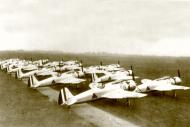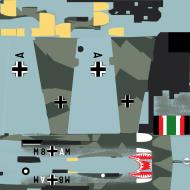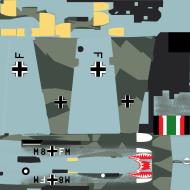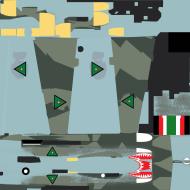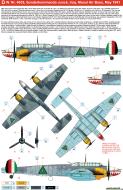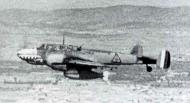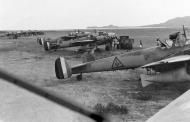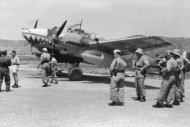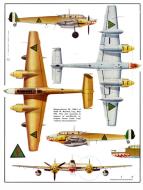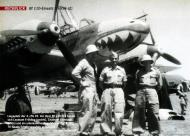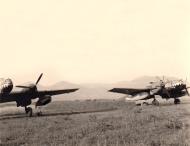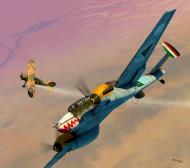While the German markings were over-painted with Iraqi symbols, many Messerschmitt Bf 110s in Iraq still featured 'shark teeth' markings of 4/.ZG76 on the nose.
Messerschmitt Bf 110D3 Zerstorer ZG26 being prepaired for SKdo Junck at Argos Nord May 1941
These two Me 110 of the ZG 26 together with another 12 of 4./ZG 76 took part with the Sonder-Kdo. Junck in the Iraqi operation in May of 1941 where they were destroyed
Sonderkommando Junck
4. Staffel II. Gruppe Zerstörergeschwader 76
Flyer Command Iraq (German: Fliegerfuhrer Irak) was a unit of the German Air Force (Luftwaffe) sent to Iraq in May 1941 as part of a German mission to support the regime of Rashid Ali during the Anglo-Iraqi War. The mission was part of a larger effort to gain support in the Middle East for the Axis Powers against the United Kingdom and its allies during World War II.
Background
On 1 April 1941, Rashid Ali and members of the "Golden Square" led a coup d'état in Iraq. During the time leading up to the coup, Rashid Ali's supporters had been informed that Germany was willing to recognize the independence of Iraq from the British Empire, there had also been discussions on matériel being sent to support the Iraqis and other Arab factions in fighting the British.
German Foreign Minister Joachim von Ribbentrop persuaded Nazi dictator Adolf Hitler on 3 May that Dr. Fritz Grobba be secretly returned to Iraq to head up a diplomatic mission to channel support to the Rashid Ali regime.[1] Grobba's mission was accompanied by a military force commanded by the Oberkommando der Wehrmacht, or OKW (the High Command of the Armed Forces). The military mission had the cover name Sonderstab F (Special Staff F); it included components from the Abwehr-based Brandenburgers and from the Luftwaffe. Sonderstab F was commanded by General der Flieger Hellmuth Felmy.[2] Fliegerfuhrer Irak (Flyer Command Iraq) was the Luftwaffe component of Sonderstab F. While Fliegerfuhrer Irak was part of the Sonderstab F military mission, it was also somewhat separate from it. Its personnel reported to the Luftwaffe High Command and not to the Chief of the OKW.[3]
On 6 May, in accordance with the "Paris Protocols", Germany concluded a deal with the Vichy French government to release war matériel, including aircraft, from sealed stockpiles in Syria and transport them to the Iraqis. The French also agreed to allow the passage of other weapons and stores as well as loaning several airbases in northern Syria, to Germany, for the transport of their aircraft to Iraq.[4]
Also on 6 May, Luftwaffe Oberst Werner Junck received instructions in Berlin that he was to take a small force of aircraft to Iraq. That force was Fliegerfuhrer Irak,[1] Junck met Reichmarschall Hermann G�ring and was named "Commander of Aviation Iraq."[5] Junck was then briefed by Generalleutnant Hans Jeschonnek, G�ring's Chief of Staff. While under Junck's tactical direction, Fliegerfuhrer Irak was to be under the overall direction of Jeschonnek. The aircraft of Fliegerfuhrer Irak had Iraqi markings and operated from an air base in Mosul, some 240 miles north of Baghdad.[1]
Fliegerfuhrer Irak was to consist of a squadron of Messerschmitt Bf 110 fighters (12 aircraft) from the 4. Staffel/ZG 76, and a squadron of Heinkel 111 bombers (12 aircraft). In addition, to assist in transporting the force to Iraq, Junck was lent 13 Junkers 52 and Junkers 90 transport aircraft. All but three of these transports had to be returned to Greece immediately to prepare for the invasion of Crete.[1].
Junck was accompanied to Iraq by Major Axel von Blomberg. It was von Blomberg's task to head a reconnaissance group that was to precede the unit[2] and to integrate Fliegerfuhrer Irak with Iraqi forces in operations against the British.[1]
Messerschmitt Bf 110E Zerstorer Sonderkommando Junck WNr 4035 Iraq Mosul Air Base May 1941
After the eruption of the Anglo-Iraqi War, which lasted from April 18 to May 30, 1941, the Italians and Germans gave their military support to the Iraqis. The Luftwaffe opposed the RAF with the unit named 'Sonderkommando Junck', which had in its inventory Messerschmitt Bf 110 fighters, Heinkel He 111 bombers, and Junkers Ju 52 transports. The unit was commanded by General Werner Junck, who, during the course of the First World War with Jasta 8, gained five aerial victories. Between the wars, he was a well known sport pilot.
The Messerschmitt Bf 110s carried Iraqi national insignia, but were manned by German crews. In fact, the aircraft in question came from ZG 76 and ZG 26. The only unit's victory coming out of this episode was gained on May 20, 1941 by Lt. Martin Drewes of II./ZG 76 (a future successful night fighter ace, when he shot down a Gloster Gladiator piloted by Sgt Smith of A Squadron, Habbaniya Strike Force, over Fallujah. Messerschmitt Bf 110 E W.Nr.4035 was found by the British after a forced landing, was repaired in September, 1941 and christened "Belle of Berlin". Later, it was flown to Egypt, to No.267 Squadron. The aircraft was written off after a forced landing en route to South Africa.
Additional Information Eduard plastic models - http://www.eduard.com/
Produced early 1941 in a batch of 104 Bf 110 E-1s (c/n 4013 to 4116) this aircraft was assigned to 4./ZG 76 (Zerstörergruppe, Destoryer Group). In early May 1941 it was one of twelve aircraft assigned to Sonderkommando (Task Force) Junck under command of Oberst (Colonel) Werner Junck in support of the Iraqi Nationalist cause and it was operated in Iraqi markings from Mosul, Iraq. On May 25, 1941 it made a forced belly landing in the Mosul area when the undercarriage failed to lock down and was abandoned, as the Sonderkommando left Iraq.
Subsequently it was found by British Froces, repaired and allotted the British serial HK846. Named "Belle of Berlin" it was test flown in September 1941 and used by No. 11 Squadron at Habbaniyah. Later it was transferred to Almaza near Cairo, Egypt, from where it was used by No. 267 (and later No. 89) Squadron for reconnaissance and liaison duties. Ultimately it was to be transferred to South Africa as part of a program to train pilots on enemy equipment but in the process of transfer was written off in northern Sudan in another belly landing, again due to failing undercarriage.
 Heinkel He 111's involved in Anglo-Iraqi War
Heinkel He 111's involved in Anglo-Iraqi War
Luftwaffe pilot Walter Nowotny 258 kills
Luftwaffe pilot Theodor Weissenberger 208 kills
Luftwaffe pilot Heinz Bar 175 kills
Luftwaffe pilot Franz Schall 133 kills
Luftwaffe pilot Rudolf Rademacher 126 kills
Luftwaffe pilot Adolf Galland 104 kills
Luftwaffe pilot Hermann Buchner 58 kills
Luftwaffe pilot Erich Hohagen 50 kills
Luftwaffe pilot Rudolf Sinner 39 kills
Luftwaffe pilot Ernst-Wilhelm Modrow 32 kills
Luftwaffe pilot Richard Altner 25 kills
Luftwaffe pilot Gunther Wegmann 21 kills
Luftwaffe pilot Wolfgang Schenck 18 kills
Luftwaffe pilot Franz Holzinger 10 kills
Luftwaffe pilot Helmut Lennartz 10 kills
Luftwaffe pilot Alfred 'Bubi' Schreiber 9 kills
Luftwaffe pilot Eduard Schallmoser 3 kills
Luftwaffe pilot Wilhelm Batel 1 kills
Luftwaffe pilot Joachim Fingerlos 1 kills
Bibliography: +
- Campbell, Jerry L. Messerschmitt BF 110 Zerstörer in Action. Carrollton, Texas: Squadron/Signal Publications, Inc., 1977. ISBN 0-89747-029-X.
- Caldwell, Donald and Richard Muller. The Luftwaffe over Germany: Defence of the Reich. London: Greenhill Books, 2007. ISBN 978-1-85367-712-0.
- Ciampaglia, Giuseppe. 'Destroyers in Second World War'. Rome: IBN editore, 1996. ISBN 88-86815-47-6.
- Deighton, Len. Fighter: The True Story of the Battle of Britain. London: Pimlico, 1996. ISBN 0-7126-7423-3.
- de Zeng, H. L., D. G. Stanket and E. J. Creek. Bomber Units of the Luftwaffe 1933-1945: A Reference Source, Volume 2. London: Ian Allan Publishing, 2007. ISBN 978-1-903223-87-1.
- Donald, David, ed. Warplanes of the Luftwaffe. London: Aerospace, 1994. ISBN 1-874023-56-5.
- Geust, Carl-Fredrik and Gennadiy Petrov. Red Stars Vol 2: German Aircraft in the Soviet Union. Tampere, Finland: Apali Oy, 1998. ISBN 952-5026-06-X.
- Hirsch, R.S. and Uwe Feist. Messerschmitt Bf 110 (Aero Series 16). Fallbrook, California: Aero Publishers, Inc., 1967.
- Hooton, E.R.Luftwaffe at War; Blitzkrieg in the West: Volume 2. London: Chervron/Ian Allan, 2007. ISBN 978-1-85780-272-6.
- Hooton, E.R. Luftwaffe at War; Gathering Storm 1933-39: Volume 1. London: Chervron/Ian Allan, 2007. ISBN 978-1-903223-71-0.
- Ledwoch, Janusz. Messerschmitt Bf 110 (Aircraft Monograph 3). Gdańsk, Poland: AJ-Press, 1994. ISBN 83-86208-12-0.
- Likso, T. and D. Canak. Hrvatsko Ratno Zrakoplovstvo u Drugome Svjetskom Ratu (The Croatian Airforce in the Second World War). Zagreb, 1998. ISBN 953-97698-0-9.
- Mankau, Heinz and Peter Petrick. Messerschmitt BF 110/Me 210/Me 410: An Illustrated History. Atglen, PA: Schiffer Publishing, 2003. ISBN 0-7643-1784-9.
- Murray, Willamson. Strategy for Defeat: The Luftwaffe 1935-1945. Maxwell AFB, Al: Air Power Research Institute, 1983. ISBN 0-16-002160-X.
- Mackay, Ron. Messerschmitt Bf 110. Wiltshire, UK: The Crowood Press, 2000. ISBN 1-86126-313-9
- Middlebrook, Martin. The Peenemunde Raid: The Night of 17-18 August 1943. Barnsely, UK: Pen & Sword Aviation, 2004. ISBN 1-84415-336-3.
- Munson, Kenneth. Fighters and Bombers. New York: Peerage Books, 1983. ISBN 0-907408-37-0.
- Price, Alfred. Messerschmitt Bf 110 Night Fighters (Aircraft in Profile No. 207). Windsor, Berkshire, UK: Profile Publications Ltd., 1971.
- Savic, Dragan and Boris Ciglic. Croatian Aces of World War II (Osprey Aircraft of the Aces - 49). London: Oxford, 2002. ISBN 978-1-84176-435-1.
- Treadwell, Terry C. Messerschmitt Bf 110(Classic WWII Aviation). Bristol, Avon, UK: Cerberus Publishing Ltd., 2005. ISBN 1-84145-107-X.
- Van Ishoven, Armand. Messerschmitt Bf 110 at War. Shepperton, Surrey: Ian Allan Ltd., 1985. ISBN 0-7110-1504-X.
- The Messerschmitt Bf 110 in Color Profile 1939-1945 John Vasco and Fernando Estanislau by Schieffer Publications. ISBN:0-7643-2254-0
- Wagner, Ray and Heinz J. Nowarra. German Combat Planes: A Comprehensive Survey and History of the Development of German Military Aircraft from 1914 to 1945. New York: Doubleday, 1971.
- Weal, John. Messerschmitt Bf 110 Zerstörer Aces World War Two. London: Osprey, 1999. ISBN 1-85532-753-8.
Magazine References: +
- Airfix Magazines (English) - http://www.airfix.com/
- Avions (French) - http://www.aerostories.org/~aerobiblio/rubrique10.html
- FlyPast (English) - http://www.flypast.com/
- Flugzeug Publikations GmbH (German) - http://vdmedien.com/flugzeug-publikations-gmbh-hersteller_verlag-vdm-heinz-nickel-33.html
- Flugzeug Classic (German) - http://www.flugzeugclassic.de/
- Klassiker (German) - http://shop.flugrevue.de/abo/klassiker-der-luftfahrt
- Le Fana de L'Aviation (French) - http://boutique.editions-lariviere.fr/site/abonnement-le-fana-de-l-aviation-626-4-6.html
- Le Fana de L'Aviation (French) - http://www.pdfmagazines.org/tags/Le+Fana+De+L+Aviation/
- Osprey (English) - http://www.ospreypublishing.com/
- Revi Magazines (Czech) - http://www.revi.cz/
Web References: +
- Wikipedia.org - https://en.wikipedia.org/wiki/Messerschmitt
 Editor for Asisbiz: Matthew Laird Acred
Editor for Asisbiz: Matthew Laird Acred
If you love our website please subscribe to our YouTube video channel
Please donate so we can make this site even better !!

